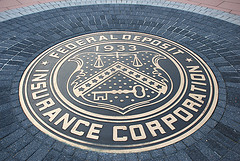FDIC Announces Plan For How To Handle Failed Banks

(afagen)
Nearly four years on from the collapse of Lehman Brothers, Merrill Lynch and a number of other large financial institutions, the Federal Deposit Insurance Corporation is announcing its plan for what will happen the next time a too-big-to-fail bank goes kaput.
In basic terms, regulators would assume control of the bank’s parent company while still allowing associated units to continue operating. Equity stakeholders would be wiped out, and bonds would be swapped for equity in the new entity.
More details from the Wall Street Journal, which was briefed on the plan in advance of today’s announcement:
If several federal agencies and the Treasury Department agree to seize a firm, the FDIC will unwind the parent bank holding company of the faltering firm, placing it in receivership and revoking its charter. The firm’s subsidiaries around the world would continue to operate, supported with liquidity the FDIC-held parent company can borrow from the government under the Dodd-Frank financial overhaul.
Next, the FDIC would transfer most of the firm’s assets and some of its liabilities into what’s known as a “bridge company,” according to FDIC officials. There, regulators would oversee a debt-for-equity swap akin to what occurs under a Chapter 11 restructuring: Equity holders would be wiped out, but creditors would get equity in exchange for the claims they held. The company eventually would emerge from the process as a new, recapitalized private entity.
The FDIC’s goal is to safely wind down the bank and thus avoid future taxpayer-funded bailouts.
One former Federal Reserve governor has expressed skepticism over the FDIC’s involvement, saying the organization “is unlikely … to be up to the task” of avoiding similar meltdowns that resulted from the bank failures in 2008 and 2009.
Avoiding the Next Big Bailout [WSJ.com]
Want more consumer news? Visit our parent organization, Consumer Reports, for the latest on scams, recalls, and other consumer issues.

